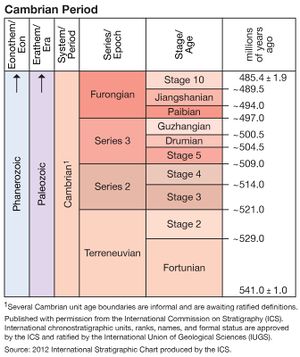Cambrian

The Cambrian was the first geological period of the Paleozoic era, extending from approximately 541.0 million to 485.4 million years ago. It is divided into four epochs: the Furongian, the Miaolingian (formerly Series 3), Series 2, and the Terreneuvian (Figure 1).[2] The name "Cambrian" was derived from "Cambria", the classical name for Wales. It was first used by Adam Sedgwick, a British geologist, in the 1800s.[3]
One of the key events of the Cambrian was the Cambrian Explosion. The Cambrian Explosion was an event where the biodiversity of Earth massively increased (Figure 2). Many new species emerged, including the first appearance of animals with mineralized skeletons. Most flora and fauna at this time was aquatic. The most dominant creatures were arthropods (animals like trilobites (Figure 3)). There are several fossil sites around the world today where the hard parts (bone, shells, and so on) of these animals and plants were preserved. These sites are called "Lagerstätten" (this is a German word that translates roughly to "Storage places") and they are invaluable to the study of past life on the planet.[3]
- Figure 2. Size comparison of some Cambrian aquatic species.[4]
- Figure 3. Cambrian trilobite artist rendering.[5]
The Cambrian period started just after the supercontinent Rodinia had broken up.[3] The world was made up of two smaller supercontinents, Gondwana and Laurentia, with two much smaller landmasses, called Siberia and Baltica. The landmasses were mostly located in the southern hemisphere, near the equator, which meant there were generally mild temperatures. There were very few terrestrial plants at this time though, so life on land did not really exist.[6]
For Further Reading
- Geologic time scale
- Geologic period
- Supercontinent
- Biodiversity
- Stratigraphy
- Or explore a random page
References
- ↑ International Commission on Stratigraphy."International Chronostratigraphic Chart v2012" Accessed Nov.12, 2018 [Online]. Available: https://www.britannica.com/science/Dapingian-Stage/media/1554752/133173
- ↑ 2.0 2.1 International Commission on Stratigraphy."International Chronostratigraphic Chart v2018" Accessed Nov.8, 2018 [Online]. Available: http://www.stratigraphy.org/index.php/ics-chart-timescale
- ↑ 3.0 3.1 3.2 Gradstein, F. M. "The Geologic Time Scale 2012". Volume 2. 1st ed. Amsterdam ; Boston: Elsevier, 2012.
- ↑ WikiMedia Commons."Burgess scale2" Accessed Nov.10, 2018 [Online]. Available: https://upload.wikimedia.org/wikipedia/commons/5/57/Burgess_scale2.png
- ↑ WikiMedia Commons."Olenoides serratus" Accessed Nov.10, 2018 [Online]. Available: https://commons.wikimedia.org/wiki/File:Olenoides_serratus_3d.jpg
- ↑ University of California, Berkeley."Cambrian: Tectonics and Paleoclimate" Accessed Nov.10, 2018 [Online]. Available: http://www.ucmp.berkeley.edu/cambrian/cambtect.html


![Figure 2. Size comparison of some Cambrian aquatic species.[4]](/wiki/images/thumb/5/57/Burgess_scale2.png/560px-Burgess_scale2.png)
![Figure 3. Cambrian trilobite artist rendering.[5]](/wiki/images/thumb/2/2c/Camb_Olenoides_serratus_3d.jpg/534px-Camb_Olenoides_serratus_3d.jpg)